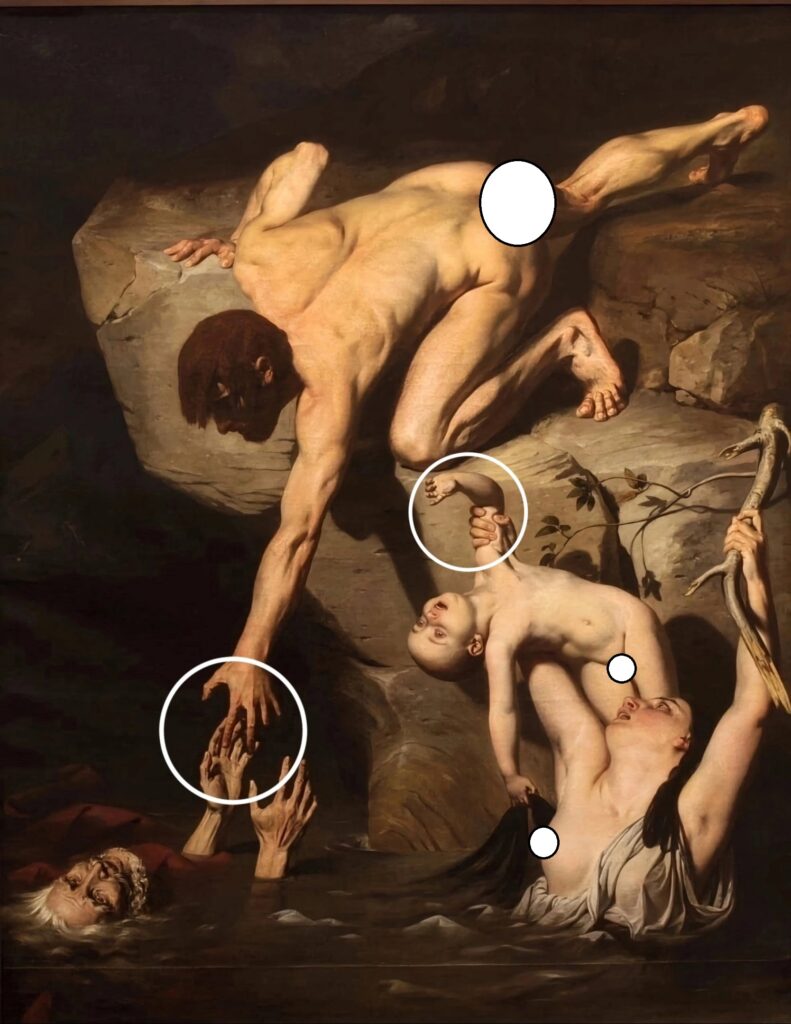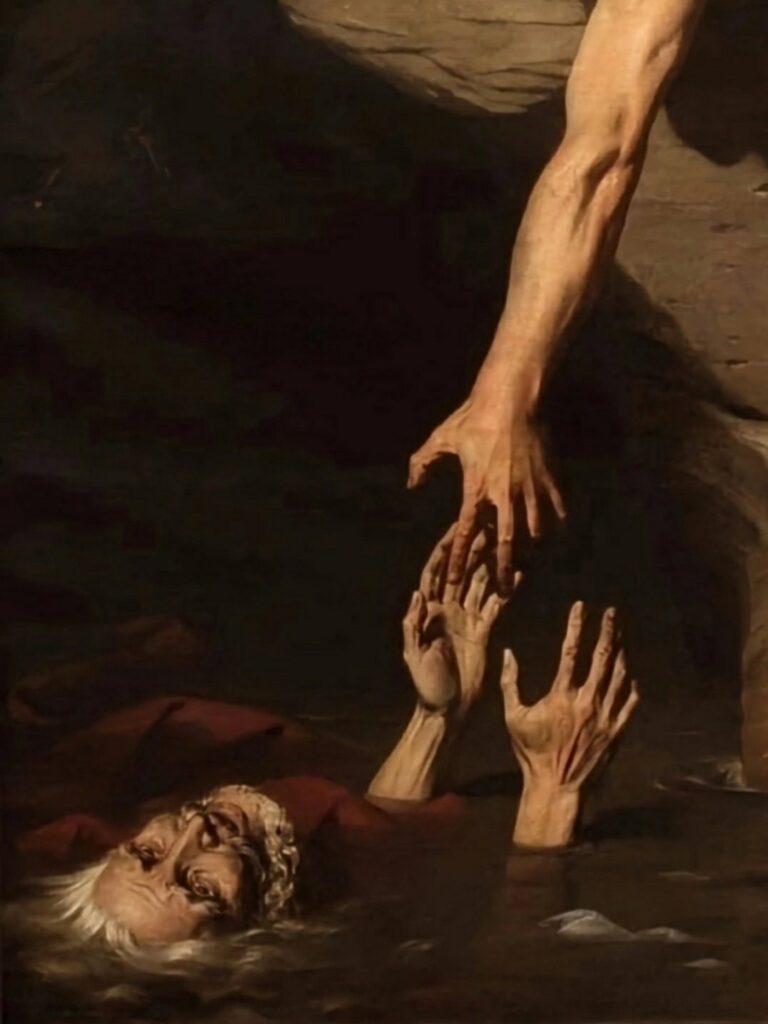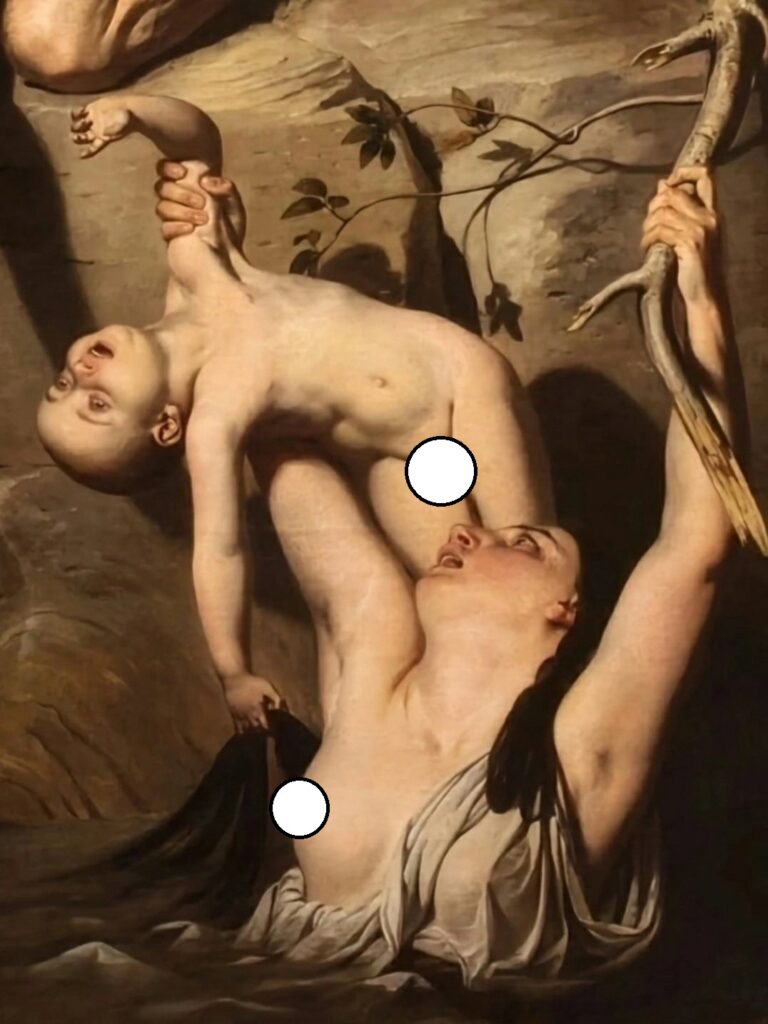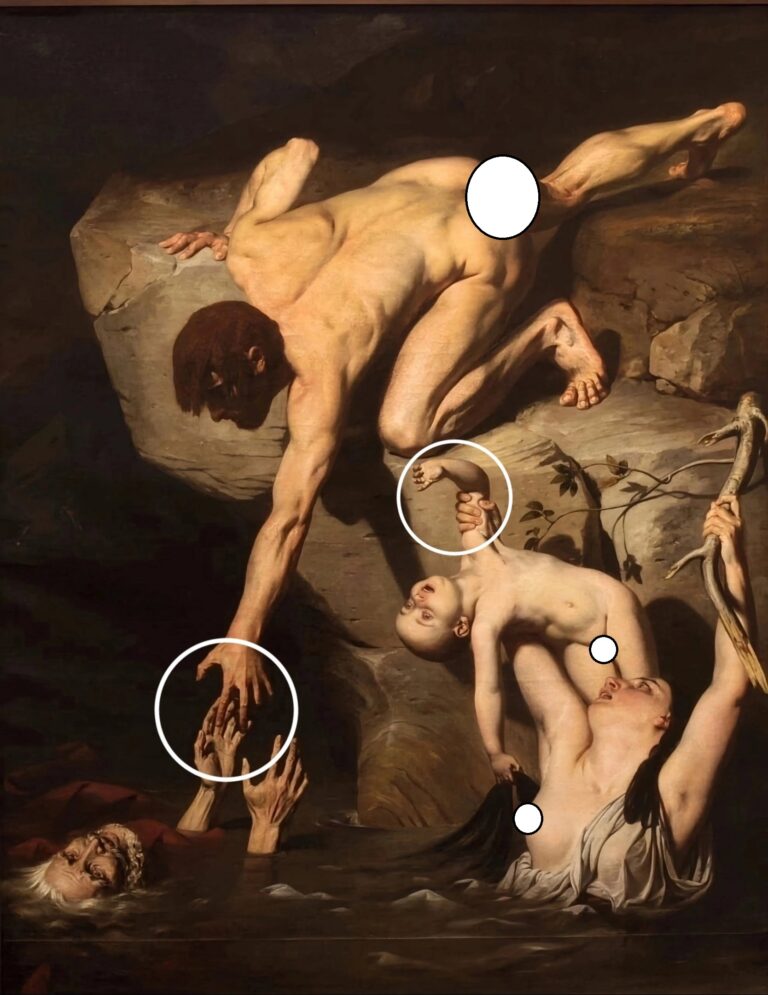The story of Noah’s Ark from the Bible is one of survival, divine will, and the preservation of life. While the flood waters swept away all living beings except for Noah, his family, and the animals on the ark, one aspect of the story has been pondered deeply: why does Noah choose to save his old father, but not his wife or son, as we see in certain artistic depictions?

In the painting “Scene of the Great Flood” by the French artist Joseph-Désiré, Noah is shown making the difficult decision to rescue an elderly father, symbolizing the past, while leaving behind his wife and son. The mother represents life, the son embodies the future, and the father is the figure of the past. This act of clinging to the past, while ignoring the present and future, leads to a symbolic loss of life and future generations.
The Old Father: Holding onto the Past
In many depictions of the flood, the father stands as a representation of the past. He is fragile, elderly, and embodies the history of what has been. In this context, Noah’s choice to save his father seems to be an act of respect and love for what has already been accomplished—the memories, wisdom, and traditions that the father carries. The old man is a symbol of endurance, wisdom, and the knowledge passed down through generations.

However, the act of saving the father can be seen as Noah holding on to what’s familiar—what has always been there. The father’s presence symbolizes comfort, but it also represents something that can no longer move forward. The past cannot continue in the same way that the future can. While Noah’s decision may appear to be a noble one, it symbolizes the danger of clinging to the past. In doing so, Noah sacrifices the opportunity for new life and the future, which are embodied by his wife and son.
The Wife and Son: The Symbols of Life and Future
In stark contrast to the old father, the wife and son in this scene represent life in its current form and in its potential future. The wife is a nurturer—she carries the present, the reality of today. She is the one who ensures life goes on, the one who connects the present with the future. The son, on the other hand, is full of potential. He is the future, a new generation ready to take what has been given to him and move forward.

By choosing to save the father over his wife and son, Noah inadvertently sacrifices the very thing that could ensure the continuation of life—his future. The wife, who can bring new life into the world, and the son, who can carry on the family legacy, are left behind, perhaps unnoticed in the flood of emotions tied to the father. This represents the danger of focusing on the past too much, to the point where we lose sight of what lies ahead.
The Dangers of Clinging to the Past
Noah’s choice is not just about saving a family member—it’s about the emotional and philosophical struggle between holding onto the past and moving forward into the future. It’s easy to become fixated on what we know, to look back on our lives and the experiences that have shaped us. The past feels safe; it is familiar, it is something we can control, and we often view it through the lens of nostalgia and sentimentality.
But what happens when we put too much importance on the past? We risk losing sight of the present, and ultimately, the future. In the case of Noah’s decision, by rescuing the father, Noah risks drowning the future—represented by his wife and son. The future, though uncertain and unknown, holds the potential for renewal, growth, and new beginnings. Without it, the past cannot continue, no matter how deeply cherished it is.
This struggle is one that many face throughout their lives. The balance between honoring the past and embracing the future is a delicate one. In focusing solely on preserving the past, we often forget that it is the future that ensures the survival of our legacy.
The Paradox of Preservation
There is a paradox in Noah’s decision. By saving the father, he preserves the wisdom, stories, and memories of the past. But by doing so, he fails to ensure the survival of those who could carry those lessons forward. The son and wife are left to perish, and with them, the continuation of Noah’s lineage.
This preservation of the past comes at a price. It illustrates the idea that, while we may strive to preserve the legacy of our ancestors and the traditions they left behind, we must not forget that it is the future that ensures the survival of these legacies. Without the future, the past is simply a collection of memories—living on only in stories but unable to influence the world as it continues to evolve.
This paradox isn’t unique to the biblical tale of Noah. It’s a theme that plays out in many areas of life—our personal relationships, our careers, and even the way society progresses. At some point, we must decide whether we will continue to hold onto what has already been, or whether we will make space for the new, for change, and for the possibilities of tomorrow.
The Struggle Between the Past and the Future
Noah’s choice to save his father is a representation of the constant struggle between the past and the future. The old man symbolizes the past—a world that has already been lived, with all its stories, triumphs, and failures. He represents the foundation upon which everything else is built. However, the wife and son symbolize the future—the part of life that has not yet been written, but holds all the potential for new beginnings and transformation.
By holding onto the past too tightly, we risk losing the future. The artist Joseph-Désiré’s painting invites us to reflect on our own lives and the choices we make. Are we so focused on preserving the past—whether it’s in our personal lives, our careers, or our societies—that we neglect the future? The floodwaters in the painting represent the consequences of this oversight. They rise, and in their rise, they wash away not just the past but the potential for a brighter future.
The Need for Balance
Noah’s story, as presented in Joseph-Désiré’s painting, calls us to consider the importance of balance in our lives. While the past is important, it should not overshadow the need for the future. The wife and son, who are left behind, represent the future we must protect. The past, no matter how precious, cannot survive without the future.
This tale serves as a reminder that, in the rush to preserve what has been, we must also make space for what is yet to come. The future is full of unknowns, but it is through the future that we ensure the survival of the past. Just as the old man, though loved and respected, must eventually pass, so too must we make room for the new—whether it’s in our families, our communities, or ourselves.
By making this decision, Noah’s act of saving the father becomes a powerful metaphor for the human tendency to hold on to what we know, even when it may cost us what we could have had. It’s a reminder that life is about cycles—about letting go of the past to make room for the future.
Conclusion: Letting Go of the Past to Embrace the Future
The tragedy of Noah’s decision in Joseph-Désiré’s painting is that by saving the past, he sacrifices the future. It’s a choice that speaks to a much larger issue: the struggle between honoring what has been and embracing what could be. The flood, both literal and metaphorical, serves as a reminder that we cannot survive on the past alone.
While the past shapes who we are, it is the future that ensures our survival. The painting and the story of Noah invite us to reflect on our own lives—on what we are clinging to, and what we may be sacrificing by holding on too tightly to what has already been. We must find a way to honor the past, while also making space for the future, for it is through the future that we live on.



0 Comments